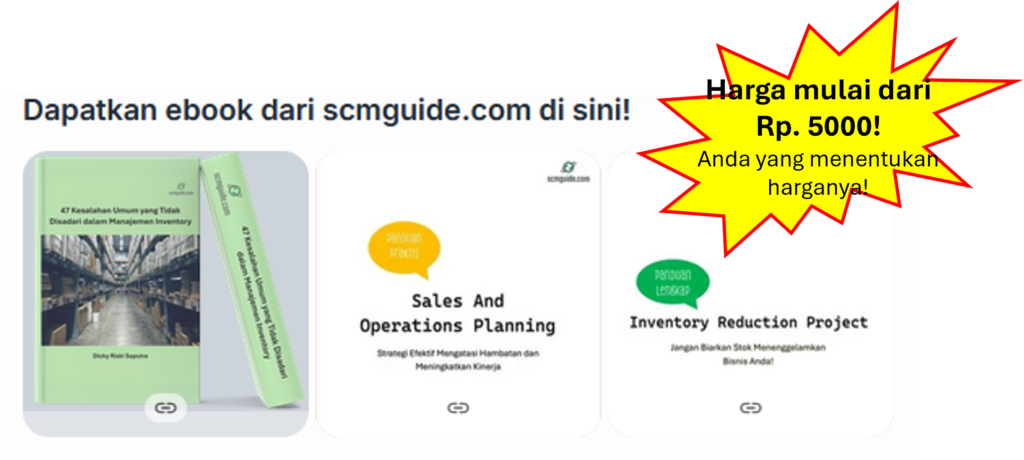In the fast-paced world of manufacturing and supply chain management, your role in the Production Planning and Inventory Control (PPIC) department is crucial for keeping things running smoothly.
But, if your department only concentrates on planning without paying attention to production control and inventory management, it can cause a lot of issues.
In this long blog post, we’ll discuss the problems that can arise from this situation and clarify your actual role in the PPIC department.
We’ll also look at important performance measures and strategies to help you and your team work at your best.
Before we go further into this topic, don’t forget to follow my LinkedIn account. You’ll get more helpful insights on supply chain management there.
Table of Contents
The Problems Caused by Ignoring Production Control and Inventory Control
Too Much Stuff and Warehouse Problems
When you don’t pay attention to production control and inventory management in the PPIC department, you can end up with too many materials and finished goods sitting in your warehouses.
This leads to higher costs for storing all that stuff and makes it hard to find what you need.
It also increases the risk of things getting damaged or going bad, costing you even more money.
Wasted Materials and Money
If you’re not careful, materials can expire or go bad because you’re not keeping track of them. This means you’re throwing away resources and hurting the quality of your products. Plus, you’re wasting money and harming the environment.
Bad Production Planning
Production planning is like the GPS for your manufacturing. But if you skip production and inventory control, it’s like driving blindfolded.

Without real-time data on what’s in stock, your production plans can go haywire.
This leads to delays, angry customers, and a damaged reputation. You might have to rush things at a high cost to fix the mess.
More Costs
Ignoring PPIC practices can drive up your production costs. Stuffed warehouses mean higher expenses for storage and security. Expired materials are a direct loss. Production disruptions force you into expensive solutions like overtime or rush orders to meet deadlines. These extra costs can eat away at your profits.
Neglecting production and inventory control in the PPIC department can lead to a series of problems that hurt your organization’s finances and operations.
Recognizing the importance of these functions is key to keeping your manufacturing and supply chain efficient and cost-effective.
You might also like:
- Choosing the Right Demand Forecasting Method for Your Business: Advantages, Disadvantages, and Considerations
- Why Wasting Employee Skills Is a Costly Missed Opportunity
Your Vital Role in PPIC - Making the Organization Successful
To fix the problems we talked about earlier and avoid having the PPIC department just focus on planning, it’s crucial for you to know what your department really does.
You have a key job in overseeing and improving the whole production and inventory process.
Let’s break down what you do and how it helps the organization succeed.
Production Planning
- Predicting Demand: Your first job is to predict what customers will want and what the market will be like. You do this by looking at past data, doing market research, and talking to the sales and marketing teams. This way, the organization makes the right things customers actually need.
- Creating Production Plans: Here, you make detailed plans for how things will be made and who will do the work. You coordinate everything from getting raw materials to scheduling the workers. Your goal is to make efficient plans that meet customer needs while using resources wisely.
- Capacity Planning: You also make sure the organization has the right tools, people, and space to meet the production plan. This includes thinking about whether more tools or space might be needed.
Production Control
- Watching Production: You keep a close eye on how things are being made to make sure they match the plan you made. You check for problems and delays in real-time.
- Quality Check: Keeping the quality of products high is super important. You make sure the products meet or beat what customers expect. This means setting quality standards, checking things, and fixing problems.
- Solving Problems: Sometimes, production doesn’t go smoothly, and that’s where you come in. You find problems, fix bottlenecks, handle delays, and make things work even when they don’t go according to the plan. Your problem-solving skills are essential here.
Inventory Control:
- Managing Inventory: Your third main job is about keeping the right amount of stuff on hand. This means watching the raw materials, works-in-progress, and finished products. You aim for a balance - enough to make things, but not too much. This saves the organization money.
- Matching Supply and Demand: It’s important to make sure there’s just enough stuff to meet customer demand. You make sure materials and products are there when they’re needed, so there’s no waste.
- Cost Control: Lastly, you help keep costs down. This includes finding ways to store and handle things efficiently and reducing waste. Saving money like this helps the organization make more profit.
In a nutshell, you’re like the glue that keeps the organization’s production and inventory working smoothly.
You do a bunch of different things like predicting, planning, checking quality, solving problems, and saving money.
By doing these tasks well, you make sure everything runs efficiently and helps the organization succeed in the competitive world of manufacturing and supply chain management.
You might also like:
- How to Build a Reliable and Trustworthy Supply Chain Management Team: You Can Lead the Way!
- Stay Ahead of the Curve: Strategies for Excelling in Supply Chain Planning with Varying Lead Times
Measuring Your Impact in PPIC - Key Numbers to Watch
As a PPIC team member, it’s important to know the numbers that show how well you’re doing your job.

These numbers tell you how effective you and your team are in making everything run smoothly.
Let’s dig into these important numbers.
Inventory Turnover Rate
This number tells you how fast you’re using up or selling the stuff you have in stock. A higher rate means you’re managing inventory well, not letting things sit around, costing money for storage.
Customer Service Level
This shows how good you are at giving customers what they want on time. A high service level means your planning and control are working. You make sure products are there when customers need them, making them happy and loyal.
Production Schedule Adherence
This measures how closely your actual production matches the plan. A high score means your production control is doing well. You’re managing manufacturing efficiently and avoiding disruptions or delays.
On-Time Delivery
Your ability to meet delivery deadlines is crucial. A high score here means you’re good at coordinating production, managing inventory, and making sure products arrive when promised. It directly shows how satisfied customers are.
WIP Inventory
Keeping an eye on work-in-progress (WIP) inventory is essential for saving money and making things work better. Your role in reducing WIP inventory helps cut costs and make production smoother.
Lead Time
This measures how long it takes to finish a production order from start to finish. Lower lead times mean you can react faster. Your work in making production more efficient and managing resources affects this number.
Production Cost Variance
This number compares what it costs to make things to what you planned. A lower variance means you’re controlling costs well. Your job in managing resources, getting what you need, and making processes better helps with cost control.
Stockout Rate
This measures how often you run out of things customers want. Managing inventory well means fewer stockouts, so customers can get what they need when they need it.
By understanding and working to improve these numbers, you show how valuable the PPIC department is in your organization. These numbers are proof of how you help make things work better, save money, keep customers happy, and make the business successful.
Boosting Your PPIC Performance - Tips for Success
To excel in your role in the PPIC department and help your organization thrive, try these strategies.
Embrace Technology
Advocate for and use advanced inventory and production planning software. These tools give you real-time data and forecasting powers, making your job easier and more accurate. Technology streamlines processes and makes your department more efficient.
Cross-Training
Learn different aspects of PPIC. Cross-train with your colleagues to understand everything about production planning, control, and inventory management. This makes you more versatile and better at handling challenges.
Regular Reviews
Take part in performance reviews in the PPIC department. These help track your progress and align your work with the KPIs we talked about. Use feedback as a chance to grow and get better.
Keep Improving
Encourage your team to always look for ways to improve. Find ways to make processes smoother and reduce waste. Your commitment to improvement can lead to better workflows and cost savings.
Communicate and Collaborate
Good communication and teamwork are crucial. Talk to other departments like sales, procurement, and production. Collaboration helps everyone work together, share important information, and make better decisions.
Learn and Grow
Invest in your own learning and suggest training for your team. Stay updated on industry best practices and new technology. This knowledge helps you make smart decisions and drive positive changes.
Supplier Relationships
Strong relationships with suppliers are important. Work closely with them to ensure a steady supply of materials. This reduces the risk of production problems and keeps things running smoothly.
Forecast Demand
Get involved in forecasting customer demand. Use data, historical info, and input from sales and marketing teams. This ensures that your production plans match what the market needs, reducing inventory issues.
By using these strategies in your daily work and sharing them with your PPIC team, you’ll not only improve your department’s performance but also make a bigger impact on your organization.
Your proactive approach to learning and making things better will help your organization succeed and run more smoothly.
Conclusion
In summary, you, as part of the PPIC department, are like the central gear in the machine of manufacturing and supply chain operations.
If your important jobs in production and inventory control are overlooked, it can cause lots of problems like having too much stuff, wasting resources, and spending more money than needed.
To make sure you and your PPIC team do your best work, organizations should recognize all the different things you do - planning, control, and managing inventory.
Keeping an eye on important numbers (KPIs) can help see how well your department is doing.
Also, using technology, getting training, and working with other teams can make you even better at your job.
In the end, a well-functioning PPIC department, including you and your team, is super important for keeping things running smoothly, satisfying customers, and making the business succeed in today’s competitive world of manufacturing and supply chains.
Your dedication to doing all your different tasks is a big part of making sure the organization works well.
I hope you find it helpful!
Please share this article with your colleagues so they can also benefit. For more insights on supply chain management, follow my LinkedIn account. You’re free to use all articles on this blog for any purpose, even for commercial use, without needing to give credit.

 by
by 
